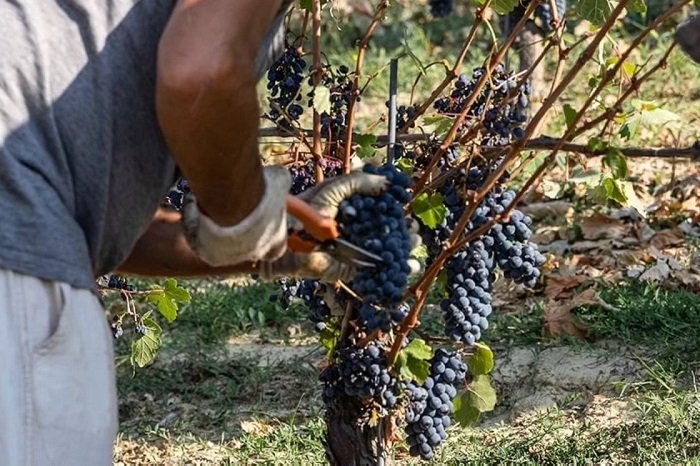Presented to G7 Agriculture the 2024 vintage estimates of Assoenologi, Uiv and Ismea. Good to excellent quality. Timid rise in production with 41 mln hectoliters.
There are an estimated 41 million hectoliters for the 2024 harvest, which marks a tentative upturn in the Vineyard Italy after last year’s ultra-light vintage .
Although registering a +7% increase over 2023 values, the 2024 harvest in fact remains distant (-12.8%) from the production average of the last five years.
This is what the official forecasts of the Assoenologi Observatory, Ismea and the Italian Wine Union (Uiv) presented today in Ortigia (SR) as part of the Expo Divination on the occasion of the G7 Agriculture. Missed the optimal target estimated by wine companies between 43-45 million hectoliters.
Constraining production potential was the now usual impact of extreme weather phenomena, from excessive rainfall in the Center-North to drought in the South.
Overall, a vintage contained in quantity but overall of good quality, with several excellent peaks.
The premises for signing an excellent vintage, despite the vagaries of the weather, are all there.
The vintage survey
The vintage survey was carried out through a process of harmonization of methodologies adopted by Assoenologi, Unione italiana vini (UIV) and Istituto di Servizi per il Mercato Agricolo Alimentare (ISMEA). These were joined by contributions from the relevant office of Masaf and the regions.
Compared to last year, there is substantial resilience in the North (+0.6 percent the performance of the macro-region), accompanied by an important recovery in the Center (+29.1 percent) and a small increase in the South (+15.5 percent), which, however, are not enough to bring production back to mid-period levels.
While the North and Center deviate from the five-year averages (2019-2023) by 5.3 percent and 5.4 percent, respectively, the performance of vineyards in the South and Islands is confirmed to be in sharp decline, at -25.7 percent.
In the global scenario, France’s drastic contraction (-18% on 2023 values) gives Italy back the world production record. Regarding the timing of the harvest, the transversality of the climatic trend has influenced the timing of the harvest according to variety, type, location and soil layout, providing a varied scenario.
In the South, where water shortage stress was joined (since May) by heat stress, harvest time was earlier, as in the Center and North for early varieties.
In contrast, late varieties in the North fell within seasonal averages.
The drought certainly had a negative impact on volumes, but the temperature trend allowed for full phenolic maturity, which is the real added value of this wine year.
Vineyard Geography Italy 2024
While taking into account the inhomogeneities determined by the peculiarities of the climatic trend in individual areas, in the Northwest there is a good recovery in Piedmont (+10% y/y), which is flanked by a substantial reduction in volumes in Lombardy (-30%), Valle d’Aosta (-20%) and, more slightly, in Liguria (-3%).
Varied is the situation in the Northeast, where moderate growth in Emilia-Romagna (+7%) is matched by a decline in Trentino-Alto Adige (-12.4%) and stability in Veneto and Friuli-Venezia Giulia.
The situation in the Center is more homogeneous, characterized by double-digit recoveries from the low 2023 production, with Marche at +25% and Tuscany, Umbria and Lazio at +30%.
In the South, on the other hand, there are significant increases especially in Abruzzo and Molise (+85% and +100%, respectively, after last year’s blight scourge), followed by Basilicata and Campania (both at +30%), Puglia (+18%) and Calabria (+10%).
With minus signs, however, were Sicily (-16 percent) and Sardinia (-20 percent) where drought now dictates the rules.
On the regional ranking front, with 11 million hectoliters and a share of 27% of the made-in-Italy harvest, Veneto is confirmed as Italy’s leading production region, followed by Emilia-Romagna and Puglia, in substantial parity with about 17%.
They are followed in the top5 by Piedmont and Sicily, tailed by Tuscany.
Climatic and vegetative trends
The season was characterized by excessive rainfall in the North Central, especially in the spring period.
While these replenished water resources, they created apprehension about the management of plant diseases, particularly Downy mildew.
Unlike last year, damage was more localized and contained, thanks in part to good planning of containment action. Among the hardest hit were areas under organic cultivation. In the South, on the other hand, sporadic violent storms, particularly in central areas, did not compensate for a months-long water shortage, which induced vine growers to anticipate the operations of a grape harvest that this year is expected to be very long.
For this reason, the weather pattern in the coming weeks will be crucial, and if weather conditions allow optimal grape ripening, especially for the later varieties, production could be more generous than estimates.
There remains the unknown of yields, which are lower than expected in some areas.
As with every year, the final outcome will be tied to the ability of companies to manage adversity effectively and in a timely manner.
The grape harvest in Europe
The impact of climate change on the sector is also evident in the European scenario, with wine production in the EU once again below average.
Weighing on the production balance in Vineyard Europe were harvests in France (down 18 percent to 39.28 million hectoliters), Germany (down 2 percent to 8.40 million hectoliters) and Portugal (down 8 percent to 6.90 million hectoliters).
On the upswing is Spanish production, which with 39.75 million hectoliters records a 20% increase on 2023 volumes and ousts France from second place in the producer rankings.
Despite difficult weather conditions and an increase in plant diseases in some areas, the quality of the harvest remains good thanks to the excellent work of winemakers.






